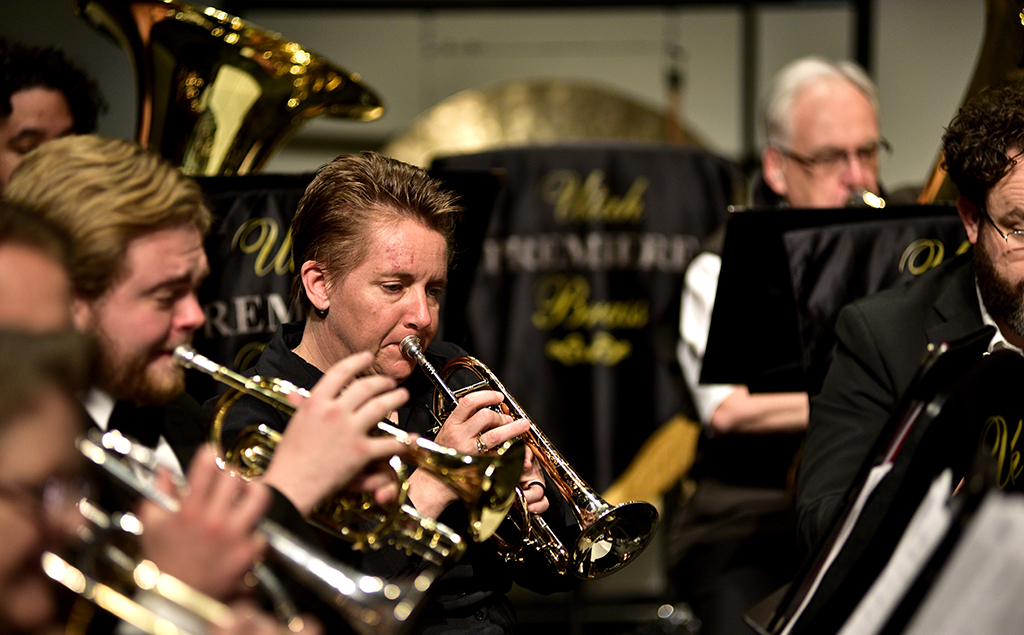About Us

British brass bands, a staple of musical life in Great Britain for more than 200 years, found their way into Utah in a most interesting and fortuitous way. These 30-piece, all-brass bands were popular in nearly every city, town, and village in the British Isles, with estimates of 10,000 to 40,000 brass bands existing in the Commonwealth during the reign of Queen Victoria. Encouraged and sponsored by mines, mills, and towns, the bands grew as a result of the industrial revolution and filled the need of music for the masses. The movement continues today, with thousands of bands operating throughout Europe, Scandinavia, and Asia. There are even a few here in the United States.
In the late 1990s, Dr. Steve Call, a professor of low brass at Brigham Young University, became intrigued with the sound of brass bands and began to study the genre. He wanted to find more challenging music for his tuba and euphonium students and expand the reach of brass bands in Utah. Doug Brown, who organized the short-lived Capital Brass Band in the 1980s in Salt Lake City, encouraged Dr. Call and shared albums with him from some of the great brass bands in the UK. Steve was hooked.
Dr. Call organized a full brass band called the Capital Brass Band to participate in the Utah UK Festival in 1996. Captain Robert Owen, director of the Band of the Light Division of the British Army and a celebrated brass band musician from Great Britain, came to Utah to direct the band. Organized just for this special celebration, the Capital Brass Band played three concerts throughout the state with former UK Prime Minister Margaret Thatcher in attendance.
At this same time, Alan Boyer, a brass band director from the UK, was in town on a business trip and heard about the band performing at the UK Festival. He contacted Dr. Call, who introduced him to Captain Owen. The three of them met to talk about establishing a permanent British brass band in Utah.
In the 1980s, Alan Boyer became the director of the Marske Brass Band, which included a cornet player named Anne Mahon. She had started her musical career as a violinist, but she was later enticed to play cornet and was thrown into a brass band on the third cornet part. After playing the Holtz Suite in E Flat at her first rehearsal, she became a life-long brass band fanatic. She worked her way up the brass band section hierarchy from a 4th section band to the championship section band that just happened to have Alan as the director. Anne said it was “love at first sight” and they were soon married. This brass band power couple relocated to Utah in 1998. Along with Steve Call, they started planning how to make the Utah Premiere Brass a reality.
In October of 1997, Dr. Call traveled to Great Britain to attend the National Brass Band Championship. He met many brass band luminaries and attended the championship concert with Captain Owens. More than 500 bands from throughout the country participated in various divisions during that year, with the finalists from the top division performing at Royal Albert Hall.
Following a tradition that began in the year 1900, each band played the same “test” piece, with judges screened from seeing the performers to prevent any bias. The piece that year was “On Alderley Edge” by Peter Graham. Dr. Call said, “I was blown away by the precision and power of the bands. I couldn’t help myself and I burst out crying, it was so amazing!”
He returned to Utah, joined forces with Alan and Anne Boyer and their son James, and began the hard work of recruiting musicians and organizing the Utah Premiere Brass. A 10-piece group was initially organized, followed by a full 30-piece band in May 2000. The first rehearsals were held at Utah Valley University, with the first concert at Snow College that fall.
In 2001, UPB was invited to perform at Pioneer Park in Provo as part of the July 24th Pioneer Day celebration. Kathryn Allen, arts director for Provo City, asked UPB to perform that day; she loved the sound of the band and became a UPB champion. She helped coordinate a yearly concert series at the LDS Provo Tabernacle along with summer concerts at Pioneer Park, which continue to this day.
Alan’s hard work with UPB led to continued musical progress. John Miller, former director of the American Fork High School Band, was also a tremendous supporter and front-bench player with the band for many years. UPB continued to perform throughout the state. Notable appearances included concerts at the Freedom Festival at Provo, the SCERA in Orem, the Governor’s Ball, Octubafest at BYU and the O.C. Tanner Amphitheater near Zion National Park.
Sadly, Alan Boyer passed away in 2018 after a short battle with cancer. Dr. Kirt Saville, who later was appointed director of the BYU School of Music, accepted the offer to become the director of the Utah Premiere Brass. The group continues today under his outstanding direction.
UPB has its own concert series at the Covey Center in Provo and performs every Sunday evening in June as part of its traditional summer park concert series sponsored by Provo City. Its goals remain the same: to bring this unique and powerful musical genre to the people of Utah and to use its influence to support school music throughout the state.
